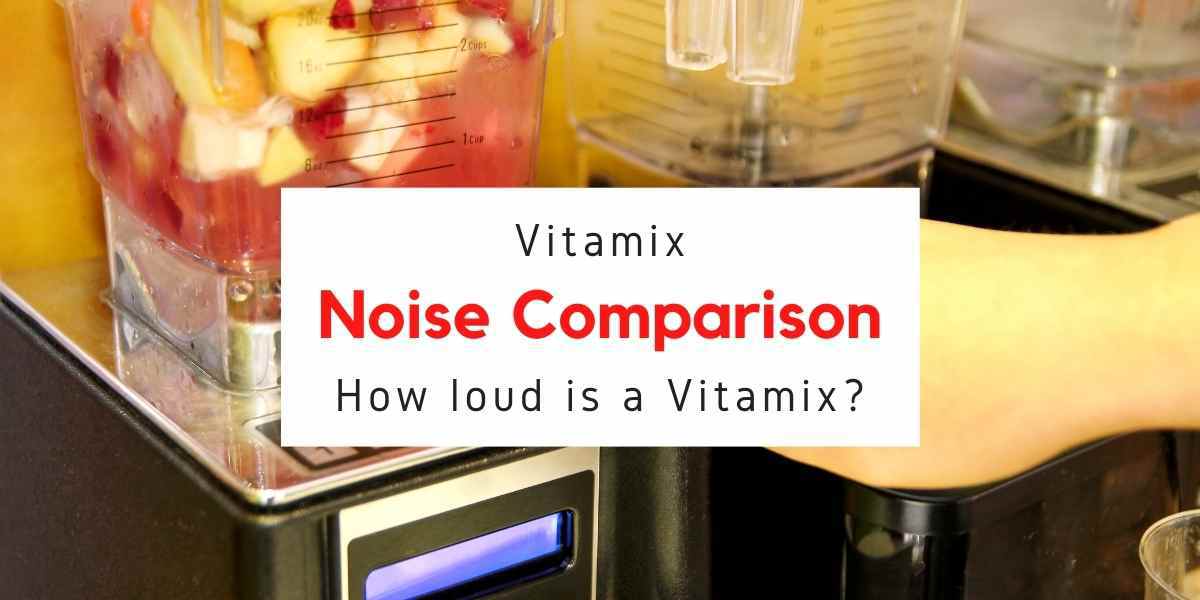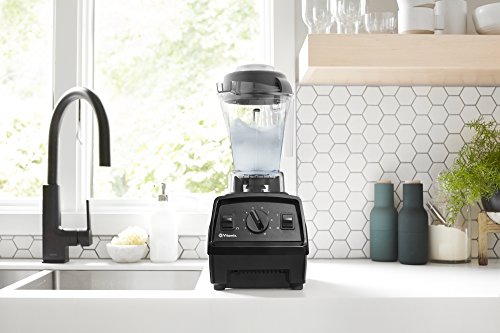You’ve probably heard the noise a Vitamix blender makes.
It can be loud and high-pitched, but is it really that much noisier than other blenders?
What does this sound like in comparison to other kitchen appliances you use on a regular basis? And how do you make your Vitamix quieter?
In this blog post, we will discuss Vitamix noise problems and suggest how to make Vitamix quieter.
Are All Vitamix Blenders Noisy?
Yes. Unfortunately, Vitamix blenders make a lot of noise. It’s not loud enough to cause permanent hearing damage, but it’s certainly going to irritate those in the kitchen as you try to blend up some delicious smoothies or soups.
My Experience With The Loud Vitamix Blender
When I first heard that Vitamix machines were really loud at the highest speed, I was surprised.
But when I actually used it for myself and decided to give it a go with my soup ingredients, that’s when things got interesting!
Wow! Vitamix is LOUD. It sounds like an airplane taking off from the living room floor .and we don’t even live near an airport!! Can you feel your ears start to ring? Are you sure this machine isn’t going to blow up?
My neighbors are going to think we have a crying baby in our house all day long seriously, how do people put up with this noise every single day??
Why Is My Vitamix So Loud?

There are a few theories for Vitamix making that loud weird noise –
1) A Vitamix is an appliance that utilizes centrifugal force to separate out particles of solids from thick liquids. The more intense the speed of rotation, the more intense the noise.
2) A Vitamix motor spins at around 27000 RPMs – that’s really fast! That means the back-and-forth motion of the blade causes friction and heat, and that friction and heat will cause sound waves and thus noise just like any other machine with moving parts would do, this includes your vacuum cleaner or child’s toy car engine).
3) The blender has sharp blades inside it that spin really fast. They’re strong enough to grind up nuts.
How Many Decibels Is A Vitamix? Vitamix Noise Levels Explained
The noise levels are in the safe range, and the quietest Vitamix is in high 80 decibels.
The loudest Vitamix is in the high 90 db, which sounds like a jet engine to some people!
But if it bothers you and you can’t make it work with one of those noisy ones, consider grabbing one of these less noisy models that are noticeably quieter than any other model.
Sounds Produced By A Vitamix Blender
So a Vitamix blender is this powerful kitchen tool, but it’s loud and uncomfortable to use? I can understand why people are put off by that!
Let me tell you about this Vitamix I found on Amazon.com. It has been rated five stars by more than two hundred reviewers, so it must be good.
My friend uses one of these and she told me how great they are.
The Vitamix makes so many different sounds! There’s the normal loud sound that comes out when you turn it on, and then there are these two other weird sounds with a high pitched whine or a growl.
It turns out that those are just warning signs of how to tell if the blades need cleaning.
The high-pitched whine means they need to be cleaned ASAP, but as long as you hear the low growl once in a while everything should be cool.
Loud Sound
The Vitamix is not the quietest blender on the market, but it is one of the most effective.
It’s also a workhorse, so you get what you pay for with this 2HP+ machine in terms of power and noise.
The sound varies depending on what type of blend you are making: if it is relatively liquid (like a smoothie or nut milk), then the high setting may be loud, but normal; if there are more solid particles that need to be finely chopped up (for example warm soup) then turn down your speed to low because otherwise, this sound can become irritatingly loud and high-pitched.
High Pitched Whine
The high-pitched whine is a sound that often scares people, but it’s actually the sign of an air pocket in the motor.
As a result, when you hear this sound your blender is running on “high” and not spinning as much as usual.
This does not mean something bad is going to happen!
The fan has no resistance so it can cool the motor and keep everything running smoothly.
It’s a sound that you might not want to hear coming from your kitchen.
The high-pitched whine is the motor running on high, and it won’t stop until you use the tamper to pop the air pocket, also called an air bubble.
The problem with having this happen is that when you’re making something thick like nut butter, ice cream, thick batters, or hummus – which require a lot of agitation in order for things to combine properly – there’s no way for the mixture to get into all of those nooks and crannies without some help.
This means that if you don’t pop the air pocket with your tamper (gently tap down on top of it), then these sounds will continue.
If you are making something thick and your motor is overheating, it will stop working.
To get a cool down without having to turn off the machine; make sure there’s an air pocket in whatever you’re mixing up so that if the sound gets too high-pitched or loud for too long, then just let it run like that for a while until things have cooled back down!
The Low Growl
The low growl indicates that the motor is working hard and not at full capacity.
The sound happens when air pockets are popped by a tamper, or the blades reach thick concoctions.
That’s what causes it to work really hard – which can lead to overheating if left unchecked for too long without any breaks in between runs of blending.
At the beginning of making your own ice cream or nut butter, you want to create a balance between the low growl and high-pitched whine.
As is true in many recipes, it’s best for these two sounds to overlap each other.
For example, when tamping down on top of an ingredient that has not been blended enough yet will cause one long sound like a “low growl” after lifting up off the ground so there can be more room for ingredients being mixed below where nothing is happening just yet, and it will produce another type of sound – higher pitched whining noise because things are still moving inside blades but with less motion due to lighter pressure from tamper.
How Much Louder Is One Vitamix Than Another? Vitamix Noise Comparison
In a nutshell, the Vitamix noise level is measured on two different scales.
One scale measures how much power it takes to operate them and another one rates how loud they are when you turn them on.
Tier 1 models have 90 decibels at full speed while tier 2’s sport 100 dBs at max RPM and so forth with higher tiers getting louder each time until we reach our top-notch model that has 140dB ratings for both variable speeds as well as idle sound levels!
The difference in decibels between these ranges might seem small but because every 10 points increase also doubles the amount of noise generated by your blender, this can make quite an impact depending upon where you choose to blend things up.
In the world of sound, there’s a difference between what we hear and how loud it is.
Though some sounds are much louder than others, when you compare two different things with decibel levels that differ by 10 dB or more (or double in volume), they can actually be perceptibly equal to our ears!
This means if one thing outputs 98dB while another only 88dB then both may seem equally as noticeable- not just because one is louder but also because the human ear cannot detect such small variances easily.
Tips For Vitamix Noise Reduction
When you’re ready to buy a Vitamix blender, it can be hard to find one that is quiet.
Here are some tips on how to dampen Vitamix noise so that it doesn’t disturb the people in your household while they sleep or watch TV –
1. Place your Vitamix on a rubber mat to reduce vibration.
2. Place the Vitamix on a countertop that is at least 8″ thick, or place it on top of an appliance like an oven or dishwasher.
3. Use the tamper tool to push ingredients down into the blades for better blending.
4. Add ice cubes and water to your blender container before adding other ingredients for more even distribution of cold air.
5. Avoid overloading your blender by not filling it up beyond its maximum capacity (which varies depending on which model you have). If necessary, blend batches in smaller amounts and store each batch in a separate container until ready to use.
6. Make sure all parts are securely fastened before using the machine.
Related Read: How To Make A Blender Quieter?
Vitamix Cover To Reduce Blender Noise
Find out if your Vitamix comes with a noise-reducing enclosure.
Look for the words “noise-reducing enclosure” or see if there’s anything that resembles a cover on the top of the blender to reduce blender noise.
Without external housing, any blender will be loud, but it might be louder than average without an enclosure because of how close sound waves are bouncing back inside the glass container.
Covering the container reduces these sounds so hopefully, your model is one that has this option.
The higher-end model – Vitamix Quiet One, does come with a noise reduction cover to make it quiet.
If you wish to purchase a sound enclosure alone, WhisperBlend has some good options for a Vitamix noise cover.
Dome Of Silence is also a good brand to purchase a Vitamix noise shield. They claim that their sound enclosures reduce the sound by at least 70%. I am not sure of the areas they ship to, so you might have to check that out.
Are The New Vitamix Models Quieter?
Yes. The new Vitamix models have been redesigned from the motor mount lid to the jar assemblies, with a better noise-reducing base and sound isolation ring that allow for improved durability and quieter operation. The new masticating models are also more powerful and less noisy.
Vitamix has also released a Quiet One package of its most popular Vitamix blender models which is even quieter than previous generations of blenders, making it 10 to 20 percent quieter than standard Vitamix blenders!
Is The Vitamix Quieter Than Ninja?
Ninja blenders are some of the loudest kitchen appliances around, but Vitamix has one of the quietest. If you’re looking for a quieter alternative to your noisy blender, look no further .
Vitamix Vs Blendtec Noise – Which Is Quieter?
Vitamix and Blendtec are two well-known brands with some of the quietest blenders in the market today.
Which is quieter, Blendtec or Vitamix? Let’s see the result of the comparisons.
The Vitamix sound is simply a blender with a higher-pitched jet engine.
The Blendtec sounds like gravel being crushed which people find more grating, as it’s deeper and for most people starts up at a lower volume before gradually going to full volume.
Personally, I can’t hear my own Blendtec over the noise of my hairdryer so they’ll have to be pretty loud for me to notice any difference – unless you’re using one in an office or library where there’s a lot of background noise they’ll stand out more obviously.
For everyone else, my guess from what I’ve been able to glean from customer reviews seems that most people prefer the Vitamix sound when compared to the Blendtec grind.
Blendtec will sound the same when it’s at low, medium, or high settings. Vitamix sounds more powerful when it’s on high speed.
Which Is The Quietest Vitamix Blender?
There is no particularly quiet Vitamix blender, but there are three quietest Vitamix blenders –
Loud
- 780
- A3500
- Pro 750 (and CR Pro 750)
Louder
- A2300
- A2500
- 5200
- Pro 500
- S30 et al
- 7500
- CR Next Generation
- CR Standard and Standard Programs
Loudest
- E310
- CR Explorian
Final Thoughts On Vitamix Noise Comparison
The Vitamix blender noise level is in the safe range. No Vitamix is particularly quiet, but they’re a few that rank among one of the – 780 (loud), A3500, and Pro 750 CR models which all fall into the category “Loud”.
The loudest model on this list would be E310 followed by CR Explorian.
To make your Vitamix quieter, place it on a rubber mat or rug for better traction and reduce vibrations to avoid the high-pitched whine that is so common with these machines.






